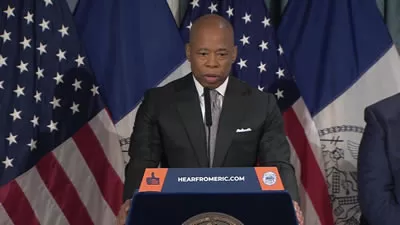Brian Lehrer: It’s the Brian Lehrer Show on WNYC. Good morning again, everyone. With us now, Mayor Eric Adams. Mr. Mayor, always great to have you on the show. Welcome back to WNYC.
Mayor Eric Adams: Hey, thanks, Brian. It’s good to be on. Many years of communicating with you and your listeners.
Lehrer: That’s right. And listeners, we have about 20 minutes with the mayor today, so it will be some questions from me and a few questions from you. So, we’re going to look for calls that are, you know, focused questions, not speeches.
So, call if you have a specific question for the mayor at (212) 433‑WNYC or you can text the question, (212) 433‑9692. And you know, there are eight million stories in the big city and so we’re not going to be able to get to all the issues we would like to talk to the mayor about in one segment. So, just saying in advance.
But Mr. Mayor, let me start here, because I don’t know if you got to hear any of our previous segment, but it was around the premise of something from your State of the City address that social media is a public health crisis, especially for young people.
So, we had a public health professor who studies how and we had a state legislator, Gounardes, who’s proposing something at the state level. My question is, are you planning to propose anything at the policy level, at the city level, not just advice to parents to limit unfettered access here?
Mayor Adams: Well, and we should be clear: this has been a space that I have been in for some time even in the time I was borough president. We brought in, it was Facebook at the time, and sat down with them. We communicated with other social media platforms because there was a clear correlation of the actions of young people and what they were seeing on social media.
It was everything from subway surfing and now as we see in our spike in grand larceny autos involving Kias and Hyunda’s is being displayed on social media, the steal a car challenge. You see how it’s impacting the mindset of our children. Suicide ideation increased by more than 34 percent.
And when you look at the impact of this, there must be immediate response, and that’s why Commissioner Dr. Vasan put in place a public health hazard. It really allows us to focus on this. And you’re starting to see other electeds coming forth with different ways that we need to really rein in how social media is impacting our children.
Lehrer: Yes. I’m curious if you saw the Florida House of Representatives — which just passed a bill that’s making national news — to actually ban kids under 16 from many social media sites and parental consent wouldn’t even matter. We’ll see if the Florida Senate goes along. But I’m curious if you’ve seen that, and if you think anything along those lines would be good for New York.
Mayor Adams: Yes, we’ve got to think differently, and we have to be extremely creative of how these algorithms are used to really zero in on our young people. They’re extremely sophisticated, and that’s why we believe a young person should not have a device until they’re the age of 14.
We held a summit last year on this and had experts come in and talk about the impact of social media. And I think that what they’re doing across the state is sending the right message.
Lehrer: So, but you wouldn’t want, it sounds like you wouldn’t want a total New York City ban. Even though you’re advising parents not to give kids smartphones until age 14, you’re not, you’re not going to propose if I’m hearing you right, a total ban on social media use by minors. Is that correct?
Mayor Adams: Well, at this time, I don’t think anything should be left off the table, just as we did when we saw the harms of cigarettes. You know, Mayor Bloomberg went further than what some of the other rules were and stated that we should not have it in restaurants. We should be extremely careful.
And so we have to peel this back layer at a time until we find the right balance to allow people the freedom of social media, but it cannot continue to impact our children the way they’re doing it.
Lehrer: Right.
Mayor Adams: And it’s going to be up to the social media companies also to step forward and make these right decisions.
Lehrer: So, it sounds like you’re open to something even potentially like Florida is doing. Let me ask you next about the experience over the weekend that’s all over the news, of City Councilmember Yusef Salaam, of course, also one of the exonerated Central Park Five who spent 10 years in prison wrongfully convicted.
Councilmember Salaam — as I’m just going to bring the listeners along on this story — was pulled over by a police officer who Salaam says wouldn’t tell him why. When the officer learned who the councilmember was, he let him go with no other interaction.
Let me play for our listeners a 15‑second audio clip of that interaction so they know what we’re talking about. We will hear the officer and councilmember both ID themselves. The officer allows the councilmember to go on his way and the councilmember asked why he was stopped and the officer does not say why. That’s a lot in 15 seconds, but here it is.
[Audio plays.]
NYPD Officer: Hello, I’m officer [inaudible] from the 26 Precinct.
Councilmember Yusef Salaam: I’m Councilmember Salaam from…
NYPD Officer: [Inaudible] Councilmember?
Councilmember Salaam: …this district, District 9.
NYPD Officer: Oh, okay.
Councilmember Salaam: Is everything…everything okay?
NYPD Officer: Yep. You’re working, right?
Councilmember Salaam: Uh, yeah. Can you tell me why I stop …why I was pulled over?
NYPD Officer: All right. Take care, sir.
[Audio ends.]
Lehrer: Can you tell me why I was pulled over, and he said, okay, take care, sir, and walked away. So, Mr. Mayor, that Councilmember Salaam and others are asking is if he asked the officer why he was pulled over and the officer wouldn’t tell him, is that okay with you?
Mayor Adams: Well, I don’t… Let’s peel this back in layers. We all saw the video, many have, and I really will ask everyone to see it. I thought this was really a picture‑perfect way of civilian, Councilmember Salaam, very polite, courteous.
I taught what to do when stopped by the police when I was a police officer. He interacted in a very calm manner to de‑escalate the situation. The officer was extremely courteous, identified himself. He was stopped because the windows’ tints were beyond the legal limit.
We don’t know if at that scene, it was on the street, there was noise. I don’t know if the officer even heard him say, can you tell me why I was stopped? Although it’s not in the law that an officer has to state why they’re stopped, I think that you want to show a level of courteousness and professionalism, and that’s what Councilman Salaam showed and that is what that officer showed.
And I think all of us should be proud of that interaction. That video shows why civilians and police can operate together to de-escalate situations.
Lehrer: You mentioned, and I read it elsewhere over the weekend, too, that the law does allow an officer to not say why he pulled over a driver. Some people say change that law to require that transparency both for police accountability and for public trust in the NYPD. Maybe human nature says if they won’t tell us why we’re stopped, we’ll be more suspicious of their motivations.
So, I’m curious from your experience on the force and obviously as mayor, would you support or oppose that kind of change in the law?
Mayor Adams: I don’t have a problem with that at all. Anything that we can do to, number one, de-escalate a situation; number two, continue to build a relationship between police and community’s a real win for me.
This is my life’s work. You know, Brian, you know that. This is what I dedicated my life to, testified in federal court to end abuse of Stop and Frisk, being arrested as a child and abused by police officers. This is my life’s work, and I think we’ve come a long way.
My fight to get video cameras on police officers with former Councilmember Letitia James. We’re seeing firsthand, so it’s not a he‑said she‑said. We’re seeing firsthand.
And if you look at that video and don’t see that the councilman and that police officer responded correctly and appropriately and professionally, I think that we are tempted to find a problem when there’s no problem. They did it right, and I’m really pleased at the professionalism of the councilman and the professionalism of that police officer.
Lehrer: And people are using this incident to talk about your veto of the City Council’s How Many Stops Act, which would require documentation of the race and gender of more New Yorkers who are stopped by the NYPD.
My understanding is that the law currently does require the traffic stops be documented in that way, so the encounter between Councilmember Salaam and the officer would have been documented, including the driver’s race and gender. Do you know if I have that right?
Mayor Adams: Yes. The conversation that we’re talking about around Intro. 586 is dealing with Level 1 stops. Those are stops such as, for example, if a person has a lost parent who’s dealing with Alzheimer’s or dementia. Everyone that officer asks, did they see the person, he will have to document that. That’s the aspect of the law I disagree with.
I support the law. I think Level 2 stops, Level 3 stops, Level 4 stops, we should definitely ensure that we expand the documentation. That’s in line of what I have advocated for for years. That stop with the councilman was not a Level 1 stop. It was documented. It was documented on paper. It was documented on the camera. It clearly shows the purpose of the stop. It is already created.
So, when people state that this is to reinforce why the law is needed, it’s incorrect. It’s documented already, and you know, it’s so important for us to understand. And that’s why I did the ride‑along so we could understand how it is policing and not, you know, make laws that really can’t reach what we want. The Council had the right spirit, but the Level 1 stops are the stops that we are in opposition of.
Lehrer: Part of the City Council’s argument is that it’s not that much work for the transparency involved to enter that into their handheld devices. You’re afraid that more paperwork — even though it’s not on physical paper, it’s on devices, but still it’s like paperwork — is going to prevent the officers from protecting the public.
Do you know how much time it took the officer on that stop of the councilmember, and did that hamper the officer from keeping the public safe in other ways?
Mayor Adams: Yes. See, and this is when we, it’s so important that we did the ride‑along, Brian, because…
Lehrer: And just so people know what that is, you invited members of the Council to ride along with police officers on Saturday night, and eight councilmembers took you up on that, right?
Mayor Adams: Yes, actually it was nine. Councilmember Selvena Brooks-Powers also rode out in Rockaway with police officers. And I just really commend them for doing so, because we should see firsthand the policies and laws we pass, how does it impact every day New Yorkers who are doing this job.
In this case, we had an incident where six people were stabbed out in Queens, and we knocked on and communicated with a thousand people we had to interview. And so, at a minimum, that’s three thousand extra minutes, 49 hours, you know, two full days in time.
So, when you talk about one individual incident, no, that doesn’t take a long time. But when it’s the accumulative of many different incidents in times it impacts that officer doing his job. It drives up overtime. It becomes duplicative. And that killer’s out there on the loose while we’re doing technical aspects of the job.
Lehrer: You refer to an example where an officer is called because somebody’s parent is having a problem, you know, from Alzheimer’s. When the City Council speaker was here on Friday, she said investigative stops are the only ones that would be included, and so that’s not that many more stops. Would you say that counts as an investigative stop, if somebody has a parent with dementia call?
Mayor Adams: Yes, it will. And we should be very clear. The definition of Level 1’s, any credible police interaction of that nature falls into that. And so if I am called to deal with a person who loved one is missing, wandering the street— something that I did a lot as a police officer— that’s carrying out an investigation: finding them.
Asking people, did you see this person? Did you see Ms. Jones? She’s suffering from dementia. And those are the interactions, and that’s why the terminology and wording is important. I think it’s imperative that up until the time this bill is executed, we should sit down and understand the terminology that are being used.
We can’t alter the definition of Level 1’s, and that is so important that we understand. Let’s get the Council what they want, because I think in the spirit of what they want is the right thing. But let’s not do it at the threat of having officers not carrying out public safety.
Lehrer: All right. Let’s get some listener calls in for you on other things. Stephanie in Brooklyn, you’re on WNYC with Mayor Adams. Hi, Stephanie.
Question: Hi. My name’s Stephanie, and I’m from Brooklyn. I have two children, a mother. I have a four month old and a two and a half year old. And I wanted to know why the mayor is cutting 170 million of 3K and Pre-K. In my school district, children are not guaranteed a spot at universal 3K.
There’s a limited number of seats, limited neighborhood outreach. And I’m a born and raised Brooklynite who wants to raise my children here, so his decision to remove funding for universal child care may force families like mine to leave the city.
Lehrer: And Stephanie, I’m going to leave it there so we have time to get as many people as we can in our limited time. She says you’re cutting $170 million from 3K and Pre‑K in the budget. Accurate? And defend it if you are.
Mayor Adams: Yes, thank you, Stephanie. First of all, we don’t want you to leave the city. A family like yours is who we want here in our city. Here’s what happened, Brian, just to give you a brief synopsis.
This, first of all, 3K, Pre‑K was on temporary dollars. It was dollars, stimulus dollars that the previous administration put in place. Those dollars are sunsetting. We have to find the right funding.
But in addition to that, we were not paying for bodies in seats, we were just paying for seats. The misalignment of the number of seats that were needed in a particular community left open. We saw that people were being paid different dollar amounts based on where they were located.
So, we saw a system that was totally not aligned correctly. We are properly aligning these seats, and our goal is to make sure every child that wants a seat will get a seat, and we have lived up to that.
The administration also cut subsidized childcare costs from $55 a week down to less than $5 a week. So, we are very much in line with making sure that we can make childcare affordable. We know how important it is.
Lehrer: Craig in the Bronx, you’re on WNYC with the mayor. Hi, Craig.
Question: Hi. How are you doing? I want to know why, instead of traveling to the border towns of Texas and Arizona to see how they’re dealing with the immigration issue for years with less infrastructure than New York City has, why would you go to Venezuela? What were you going to do? Tell them not to come? I don’t understand.
Lehrer: Well…
Question: You should [inaudible] governors to figure out how to fix this.
Lehrer: Craig, thank you. I’m going to leave it there, but you hear the question, Mr. Mayor.
Mayor Adams: Yes. No, thankful for his question. And you know, I could just pick up in his voice he’s feeling what a lot of us are feeling. We’re all angry about the national response.
And just for his knowledge, my first trip was to the border. I went to El Paso, Texas, with a delegation; and even before I went I sent another get delegation down to take a look at how they’re handling it, and they’re not handling it. People were sleeping in the streets. People were sleeping around churches. They were sleeping in airports. And so they were not handling the problem.
I went to the Darién Gap, and Venezuela, Colombia and Ecuador and Mexico, to… Not to Venezuela, I’m sorry. Colombia, Ecuador and Mexico to see the origin of the problem and to communicate with the local officials there. And it was extremely informative. Like Colombia, for example, they were willing to help buffer some of this flow if we give them some support from the national government.
And so many people don’t know, I don’t have the authority to deport people, that’s a federal authority, I don’t have the authority to tell the buses they can’t come in, that’s against the law. I don’t have the authority to say we’re not going to feed, house and clothe people, I’m binded by law.
So, many people are saying, Eric, why don’t you fix the problem? It’s a national problem. Cities should not have to fix national problems, and we’ve done an amazing job with over 170,000 migrants and asylum seekers that have come to the city. Over 60 percent we have very self‑sustaining.
And so I say to the caller and others, when you look at what this administration has done, other cities and states have acknowledged the awesome job that we have accomplished.
Lehrer: Here’s a follow‑up on the Yusef Salaam stop from a listener writing a text message. It says, based on the answer by the mayor that Councilmember Salaam was pulled over for illegal tinting, illegally too dark tinted window, and nothing happened beyond introductions. Doesn’t that pose other issues with the system?
I think the listener is asking, did the officer give Salaam special treatment because he’s a city councilmember? What would happen if someone else was pulled over for the same thing?
Mayor Adams: Well, the power of discretion. We always give officers discretion of the interaction. I’ve pulled over people as a police officer because of a traffic or vehicle infraction and I will give them a warning. It could be anything from a broken headlight. It could be anything from a darkened tint. You say, you know, you let them know what happened.
And I think the officer wanted to show a level of professionalism to the councilman and use the power of his discretion. That is allowed. There was no violation of police procedure that that officer carried out. He utilized his power of discretion on how he moved forward.
Lehrer: We get one more caller in for you. Sean in the Bronx, you’re on WNYC. Hi Sean.
Question: Hi, Mr. Mayor. I am a member of SHOUT, the Supportive Housing Tenants Group. And we actually have questions about your plans for supportive housing. We want you to fund voucher programs instead of build new supportive housing, because you’re proposing 3,000 units, probably at a cost of like a million dollars per unit, and we could do Moving On and get 15,000 people out of supportive housing at a tiny fraction of the cost of what you’re spending.
Also, there’s the 5,000 empty units scattered around the city. You could renovate those apartments for a tiny fraction of the $1 million per unit.
Lehrer: And Sean, I’m going to get a reaction from the mayor. Mr. Mayor, you’re hearing Sean.
Mayor Adams: Yes. No, thanks, Sean, for that call. When you do an analysis of the success we’ve had, we have an inventory problem. In addition to renovating new units, making sure the process of those who apply for housing are able to get in. There was such a bottleneck and the difficulties just in doing so.
But our challenge, Sean, is an inventory problem. We have to build more. And there’s not just one path the way. I like to say there are many rivers that feed the sea of, you know, the lack of housing. We need to dam each river that’s stopping it or open those rivers to flow. We need to build more housing, we need to get support from Albany, and we need to support our City of Yes.
So, I agree, let’s fill the units that we have available. Let’s make it easier for people to get in. But if you’re walking around with a voucher like many people are, but they can’t get in housing because we don’t have the units for people to get in.
So, it’s a combination: building, renovation, and ensuring that we even get a state‑wide look at the voucher plan, and that’s why we allow the vouchers to be used throughout the entire state. So, Sean, yes, I’m with you, but there’s many ways we have to get people into homes.
Lehrer: One other thing on housing, which of course, is such a big issue for so many New Yorkers — and then we’re out of time.
Did you see the report that a new affordable rent building going up and inward got 80,000 applications for 174 apartments? I wonder if you would just like to expound on the meaning of that.
Mayor Adams: I think it reinforces what I just stated. Think about it, 174 units, 80,000 applicants. What does that say? It is saying that we don’t have enough stock, so we need to be looking at raising the FAR. We need to be looking at, looking at almost 136, 138 [million] square feet of available real estate in business districts that we can convert to housing.
We need to look at our plan of City of Yes, you know, using accessory dwellings and finding ways to build. We had a discriminatory housing policy in this city where certain communities was not having their fair share. We are saying every community should build a small amount that will start accommodating.
And really integrating our neighborhoods. Access to good schools, good food, good transportation, that is how you really stop the segregations in our community and allowing people to live in every part of this community. So, let’s build more and that’s a real reflection.
Lehrer: It’s a shame the city has to go so much of this alone, right? But do you need to say anything about not in my backyard opposition, even within the city? We know what’s going on at the state level and how a lot of the communities around the city are refusing to help with this.
But a councilmember from the East Bronx just lost, a Democrat lost to a Republican — so rare for the Bronx — largely because of backlash to a development approved for there. Do you need to say anything to New Yorkers? And then you can say anything else you want about anything on your way out. But anything to New Yorkers about not in my backyard opposition, even within the city?
Mayor Adams: I hear it all the time. You hear people march on Monday for “housing is a right” and on Tuesday they’re trying to block a development project in their community. And it’s just wrong. We need to make sure that we become a City of Yes, and that real reflection on that one project, 174 with 80,000 people looking at those units, I think it just really yells that we need to build more housing.
And we as New Yorkers, we have to move away from the discriminatory practices of the past. Our project out in Willets Point, our project in the Bruckner Project, our project in Innovation Queens, you’re seeing us going into communities that historically, people were just afraid to say to their neighbors that we need to allow more people to come into our community and be a part of this wonderful experience. And I’m going to continue to advocate that.
So, I want to end on a real strong note. So, think about, we made it clear from the time I ran that we’re going to invest in people, public spaces and spaces and make this place, city more livable. Crime was surging, our economy was hurting, Covid just engulfed our city.
Look at us now, you know, largest private sector jobs in the history of the city. Crime is down, jobs are up, 62 million tourists, AA bond rating from the bond raters, over four million people back on our subway system. You are seeing decrease in homicides and shootings.
Just the city is vibrant and is thriving and I’m really excited about the next two quarters. You know, we went into the locker room after the first two quarters and we’re coming out and making some adjustments and we’re going to keep trending in the right direction.
Lehrer: Thanks, Mr. Mayor. Always good to talk at the little Bayside High School Alumni Association together.
Mayor Adams: [Laughter.]
Lehrer: Maybe we’ll bring Speaker Adams on, and you know, have a three‑fer. Maybe we’ll go up to the athletic field and do it for the graduating seniors one day. But let’s do this more often, but thanks very much for today. We always appreciate when you come on.
Mayor Adams: Thank you. Take care.
January 29, 2024 New York City Hall
Source: NYC.gov – Midtown Tribune news
Big New York news BigNY.com








